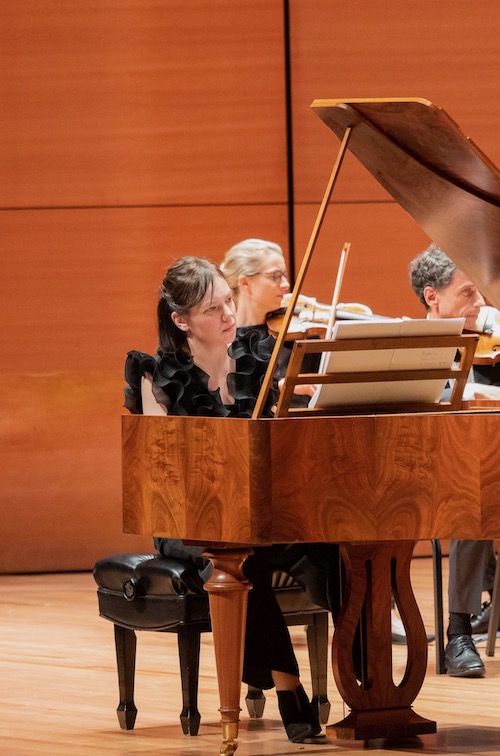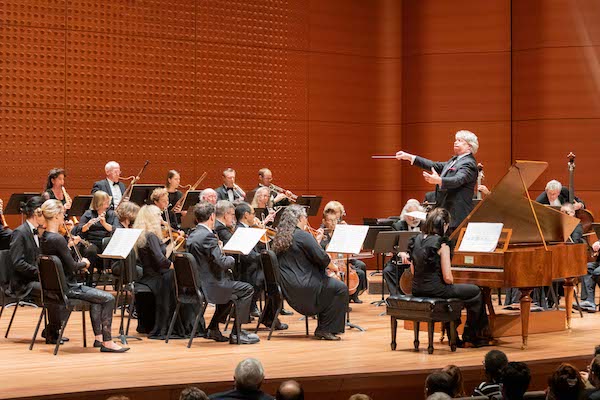Somlai’s dazzling Beethoven lights up American Classical Orchestra opener

Although New York is the place of superlatives, for some being the best period-instruments orchestra in this city might seem like being the best baseball team in Abu Dhabi. But while the ideological storms over historically-minded performance rage in London or Boston—is it authentic? what does authentic mean? do you care, as long as it sounds good?—Gotham’s own American Classical Orchestra, founded decades ago and still led by Thomas Crawford, goes its merry way each season with the modest goal, its program bio says, of “inviting listeners to enter the sound world of the great masters.”
Crawford and his band renewed that invitation Thursday night at Alice Tully Hall with a season opener featuring two composers who stretched the definition of “Classical” (Ludwig van Beethoven and Franz Schubert), one who seemed to defy definition altogether (Carl Philipp Emanuel Bach), and an undebatably brilliant solo turn by Hungarian fortepianist Petra Somlai.
The conductor, as is his wont on these occasions, began the evening by giving a brief oral summary of his printed program notes, cuing musical illustrations from the orchestra. Crawford’s genial presentation held one’s attention for a while, but he got the loudest applause when he offered to wrap up the talk and start performing music.
Still, it was well that he had alerted listeners what to expect from C.P.E. Bach, a most eccentric apple that landed far from the tree of his famous father J.S. Bach. There were moments during the son’s Symphony in F major, Wq. 183/3, when the wacky modulations and non sequiturs swarmed so thick that one wondered whether C.P.E.’s fictional brother P.D.Q. Bach had gotten into the act.
But amid all of this “shock value,” as Crawford called it, the conductor successfully managed orchestral textures ranging from beefy tutti down to just an instrument or two tossing a phrase around, notably during the mournful Larghetto. The symphony closed with a scurrying Presto dotted with sudden pauses and switches from forte dynamics to piano and back.
In addition to the composer’s deliberate misdirection and disorientation, it seemed at times the orchestra was having difficulties of its own with coordination and tuning. But the strong personality of the composer whom Joseph Haydn called “the great Bach” came through clearly.
A different, even more powerful composer personality shone through the performance by fortepianist Somlai of Beethoven’s Piano Concerto No. 3 in C minor. After Crawford and the orchestra set the scene with a robust, rhythmically precise exposition, Somlai immediately demonstrated the tonal range of her period instrument, a replica by Rod Regier of a design by Beethoven’s contemporary Conrad Graf. Scales flashed, octaves clattered, a soft answer caressed, and with a little help from Tully Hall’s friendly acoustic, one easily left Steinways behind and entered Beethoven’s “sound world.”
Playing in time but with delightfully malleable phrasing, Somlai took full advantage of her instrument’s biting attacks in forte and subtle nuance in softer passages. Her rich musical imagination was in evidence throughout, especially in the first movement’s cadenza, stormy and dreamy by turns. After she and the orchestra whipped up an exciting coda, the audience cheerfully broke the taboo on applause between movements.
The rapt Largo was all about dialogue: between a delicate solo instrument and rich orchestral textures, aglow with horns and muted strings; between a rippling fortepiano and luminous wind solos; and between a simple melody and florid cantabile passages. The fortepiano’s sharp attack kicked off the rondo finale in style, and orchestra and audience alike seemed to relish the “wait for it” cadenza-like flourishes (Eingang) that led back each time to the main theme. With Somlai’s digital prowess, the hurry-up coda sounded especially scintillating on the period instrument, bringing the concerto to a thrilling close.
The rhythmic precision that so enlivened the Beethoven performance took a holiday in the first movement of Schubert’s Symphony No. 5 in B-flat major, D. 485, at least in the softer passages and the lyrical second theme, where phrases blurred a little and the beats tended to trip over each other. In the speedy tempo, tasty details like the violins’ scampering first phrase passed almost unnoticed. The forte marcato moments fared much better rhythmically.
The 19-year-old Schubert was not yet cultivating the “heavenly length” of his later works, so this economical, Mozartean symphony is a brief encounter to begin with. Performed on Thursday without the indicated repeats in the first and last movements and at the fast tempos now in fashion, it seemed to fly by. But there were pleasures along the way, as in the Andante con moto, where a gentle drumbeat of eighth notes cured some initial rhythmic problems and a fine chemistry of silvery strings, ripe horns, and glinting woodwinds delighted the ear.
The minuet, marked Allegro molto, bounded out like a scherzo, but right in time, to bracing effect. The more relaxed tempo of the major-key trio, not indicated in the score, nevertheless suited the moment. The concise finale, in sonata form with no coda, was distinguished by right-on rhythms and a creative mix of orchestral colors, especially in the adventurous development section.
The American Classical Orchestra conducted by Thomas Crawford, with Yulan Piao, soprano,Heather Petrie, mezzo-soprano, Lawrence Jones, tenor, Joseph Charles Beutel, bass, and the ACO Chorus, performs Mozart’s Requiem and the world premiere of Thomas Crawford’s Elegy 8 p.m. Oct. 28 at Alice Tully Hall. aconyc.org.







